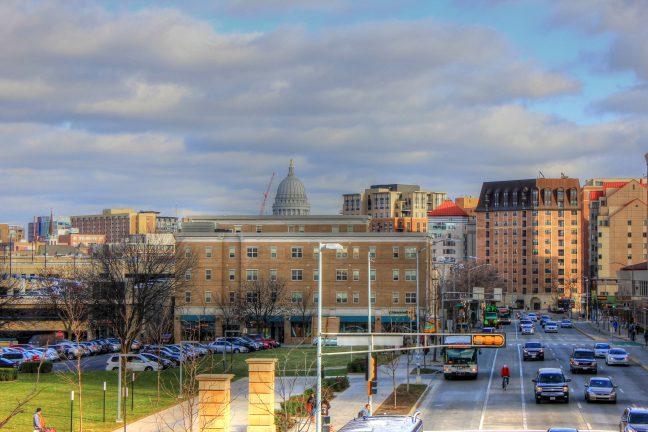GreenPower, a job training program within the Madison’s Engineering Division that prepares students for careers in the solar energy sector, has completed its 12th solar panel installation. Mayor Satya Rhodes-Conway symbolically flipped the switch on the array’s inverter at a press conference Aug. 23.
The installation, which is at the Goodman Maintenance Facility, will generate enough electricity to power 12 homes, Engineering Division spokesperson Hannah Mohelnitzky said.
“The GreenPower program is in its fourth year now, I hope it has many more years to come,” Rhodes-Conway said. “We’ll just keep finding roofs for you to put solar up on.”
The GreenPower Program, started in 2016 by the Engineering Division to prepare individuals from underrepresented populations for employment opportunities in the rapidly growing solar energy industry, is a six month program designed to provide classroom training in basic photovoltaic technology with on the job training through installations at various city facilities, Mohelnitzky said.
These installations reflect the city’s broader commitment to reduce its energy carbon footprint. The installation makes the Goodman Facility the 23rd city building to have solar power, Joel Roltgen said at the press conference, who is an advisor for Focus on Energy, a program that partners with utilities in Wisconsin to reduce energy consumption.
The city has a long way to go to meet its 2017 resolution goal of drawing 100 percent of its energy needs from renewable sources by 2030 for all city operations. Under the resolution, the rest of the Madison community including businesses and private residences would have until 2050 to make the same transition.
In early 2018, the Engineering division hired Stacie Reece as its first sustainability coordinator to bring the city closer to its goal. Reece works across departments to incorporate sustainability across a wide range of city operations in areas including transportation, waste management and energy.
Madison’s operations currently draw 49% of their electricity from renewable sources, Reece said.
For now, the primary renewable energy source will continue to be solar energy for economic and practical reasons, Reece said. The price for solar installations has dropped considerably. Furthermore, the city does not need to acquire land for solar installations, which can be easily installed on the roofs of city buildings. Wind turbines, which must be placed a certain distance away from roads and buildings, are significantly less feasible to install in an urban area like Madison.
The GreenPower program tries to do two to three solar installations a year. The program’s next project will be a solar installation at the Madison Metro Bus Barn. The project should be completed by the end of this year, Mohelnitzky said.
“Really [the GreenPower program] is the idea of workforce development and clean energy at the same time,” Reece said. “It provides hands on training from start to finish on solar installations, so individuals can be employable in a hugely growing market for renewable energy.”
From 2016 to 2017, the solar energy job sector grew by 24.5%, according to a report published by the Environmental Defense Fund.
Madison is the 25th city in the US to adopt this goal of drawing 100% of its energy needs from renewable sources. Over 100 other cities have set similar goals, Reece said.
Since President Trump’s decision to withdraw the U.S. from the Paris climate accords, efforts to reduce carbon emissions have fallen to individual states and cities. Just after the decision, Dane County announced plans to stay in the agreement.
Madison is a member of the Urban Sustainability Directors Network, a group of municipalities that share out ideas and discuss sustainability goals, Reece said.
“We’re amongst friends when it comes to other municipalities that are setting goals for renewable energy,” Reece said. “We can learn from each other and not have to reinvent the wheel.”
One particularly challenging aspect of the 100% renewable energy goal is that energy for heating and transportation come almost entirely from fossil fuels. During Madison’s frigid winters most buildings use natural gas heating. For heavy-duty transportation, alternative energy vehicles have not been established. This means that at least for the time being, carbon offsets must form a part of the renewable energy pie, Reece said.
Carbon offsets are economic ways of compensating for greenhouse gas emissions. The city plans to follow certain guidelines when purchasing renewable energy credits, Reece said. An REC is a specific type of offset which exists as a certificate corresponding to an amount of energy produced by a renewable source elsewhere.
RECs should be for new projects rather than existing ones. That way the city will actively help start new renewable energy projects that will add renewable energy to the grid, Reece said. Also, those projects should be relatively local even if they are not directly in Madison.
“We’re really making sure [the renewable energy projects] are in our backyard, a stone’s throw from Madison,” Reece said.


